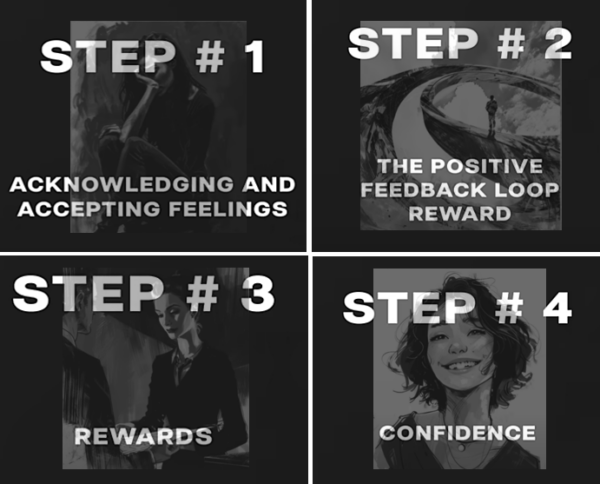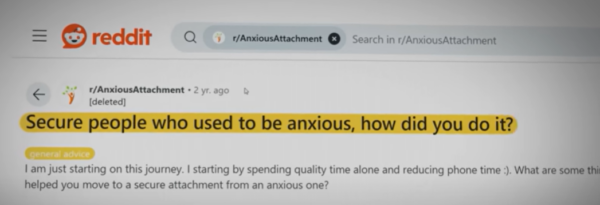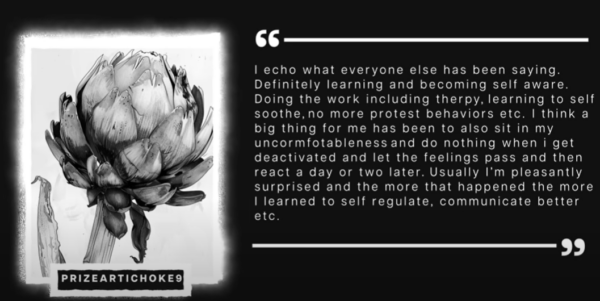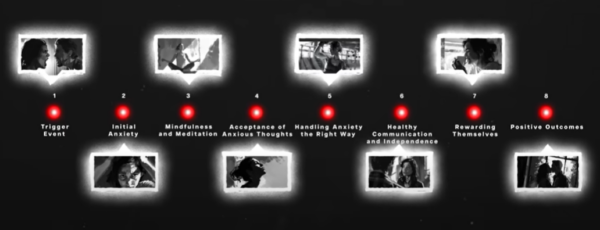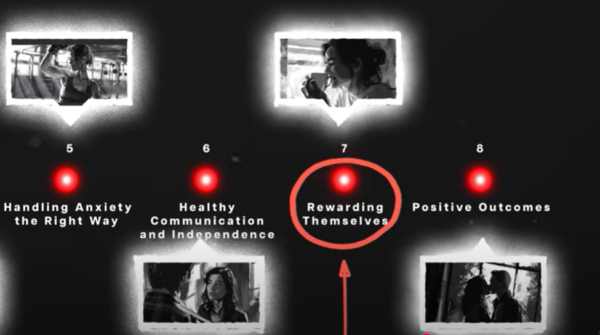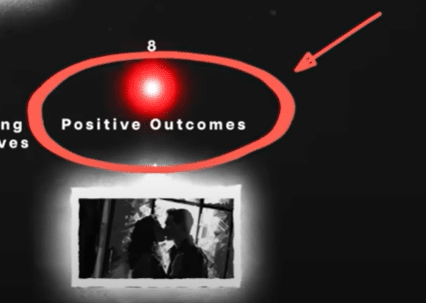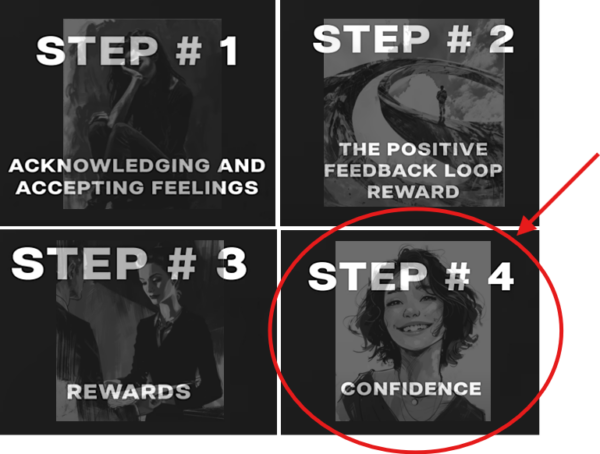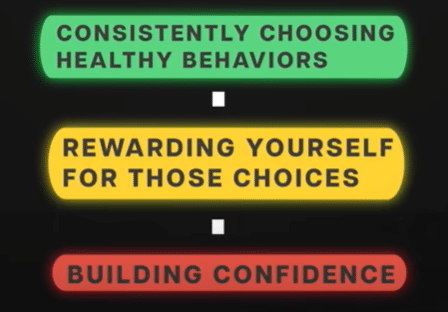So, you have an avoidant and they’re pulling away.
The natural reaction for someone with an anxious attachment is to chase.
But those with a secure attachment are a little different.
They override the anxiety, they don’t chase.
In fact, secure individuals often thrive when people pull away from them
How? What are they doing that the rest of us aren’t?
Well, to put it frankly, they’ve reprogramed their mind to become immune to these types of situations.
And they’ve done it through four steps.
Let’s tackle step one:

What Are Your Chances of Getting Your Ex Boyfriend Back?
Take the quizStep 1: Acknowledging and Accepting Feelings
The internet often portrays individuals with a secure attachment style as this unwavering north star. It’s almost like they are immune to insecurities.
Yet, even secure individuals experience anxiety and insecurity, just like everyone else. The difference lies in how they handle these feelings.
Secure individuals are keenly aware of their emotions. When anxiety hits, they don’t ignore it or push it away. Instead, they acknowledge its presence. They don’t judge themselves harshly for feeling anxious.
Look at this,
This is a reddit post I found on the subreddit: “Anxious Attachment”
The original poster asks, “Secure people who used to be anxious, how did you do it?”
And that original poster gets a response from this guy, Prize Artichoke,
Who says,
So, when a secure person starts to get anxiety, Instead of thinking, “I shouldn’t feel this way,” they think, “It’s okay to feel anxious sometimes.”
They take a moment to reflect on why they might be feeling anxious. And then they accept their anxiety as a natural response to a challenging situation.
You see, Secure individuals understand that it’s normal to feel uneasy when an avoidant partner pulls away.
They show themselves compassion and recognize that everyone has moments of insecurity, and it doesn’t make them any less secure in their overall attachment style.
Rather than suppressing or denying their feelings, they allow themselves to feel the anxiety. This acceptance reduces the intensity of the emotion, making it easier to manage.

What Are Your Chances of Getting Your Ex Boyfriend Back?
Take the quizBut things always click for me when I tie it to a story or an example.
So, let’s play a game.
Imagine you are a secure person whose avoidant partner starts pulling away from them. You feel a wave of anxiety. You don’t chase your partner or react impulsively, you pause and acknowledge your anxiety.
Maybe you’ll state the facts to yourself, “I’m feeling anxious because my partner is pulling away.”
You’ll self soothe and think, “It’s okay to feel this way.”
You’ll show yourself compassion. Maybe practice mindfulness, take a few deep breaths and focus on the present, “Right now, I’m safe. I can handle this moment without needing to react impulsively.”
Ok, ok, that sounds good right? And it’s technically all correct.
But the question I had when researching this topic was how do you implement it. Knowing what to do. Knowing that a secure person should act a certain way when they’re being stonewalled is all very nice but implementing it is an entirely different thing.
This next trick is really where the secure attachment style begins to shine and quite frankly where the reprogramming of your mind comes into play.
Step 2: The Positive Feedback Loop Reward
Most people with insecure attachment styles are caught in a negative feedback loop. Let’s take a look at the “avoidant who is pulling away.”
We start first at the beginning with the,
- Initial Connection: The avoidant individual starts a new relationship, often experiencing initial excitement and interest.
Then after that relationship has been going on for some time,
- The Need for Space Occurs: As the relationship progresses, the avoidant person begins to feel overwhelmed by intimacy and closeness. This triggers their need for space and autonomy.
Next up we have pulling away,
- Pulling Away: To regain their sense of independence, the avoidant partner starts to pull away, becoming distant and less emotionally available.
In response,
- Partner’s Reaction: The partner, often with an anxious attachment style, responds to this distance with increased anxiety and attempts to reconnect, which can include seeking reassurance, being overly attentive, or demanding more closeness.
Which in turn creates,
- Increased Withdrawal: The avoidant individual perceives the partner’s attempts to reconnect as pressure and intrusion, leading them to withdraw even further.
- Relationship Breakdown: This cycle of distancing and pursuing creates tension and conflict, eventually leading to the breakdown of the relationship.
- Escape and Repeat: After the relationship ends, the avoidant individual feels relief from the pressure of intimacy but eventually starts to feel lonely. They enter a new relationship, only to repeat the same pattern.
So, really two people in this example are being harmed by the negative feedback loop.
The Avoidant: The avoidant individual is harmed by being stuck in a cycle of shallow, unfulfilling relationships. They never fully experience the depth and stability of a committed relationship because they continually pull away at the first sign of intimacy. This prevents them from forming meaningful connections and reinforces their fear of closeness.
The Anxious: The anxious partner is harmed by the constant emotional turmoil and anxiety caused by their partner’s withdrawal. They are left feeling insecure, unworthy, and constantly in fear of abandonment. This cycle exacerbates their anxiety and dependence on their partner for validation, preventing them from developing a secure sense of self-worth.
And that is what makes secure people so special in my mind. They aren’t in this cycle. Rather, they are in their own positive feedback loop.
And it all starts with this guy right here,
BF Skinner, an American psychologist, behaviorist, inventor, and social philosopher.

What Are Your Chances of Getting Your Ex Boyfriend Back?
Take the quiz
He is best known for his research on operant conditioning.
“In a nutshell, operant conditioning is the idea that behaviors are influenced by the consequences that follow them. People tend to gravitate towards behaviors that make them feel good, because these behaviors are rewarded, and they tend to resist behaviors that make them feel bad, because these behaviors are punished or result in negative outcomes.”
For example, if you feel anxious and then engage in behaviors that help you feel calm and centered, like mindfulness or self-soothing techniques, and you reward yourself for these healthy behaviors, you’re likely to repeat them.
On the other hand, if you chase after someone who is pulling away and feel worse as a result, you’re more likely to resist that behavior in the future.
Secure individuals have mastered this concept. When faced with anxiety, they engage in positive behaviors that calm them and make them feel good, then they reward themselves for handling the situation well. This creates a positive feedback loop where healthy behaviors are reinforced, leading to more secure attachment styles and healthier relationships.
But again, I learn best from seeing real examples. So, let’s actually look at how a secure person handles an avoidant pulling away:
- Trigger Event: An avoidant partner pulls away or becomes distant.
- Initial Anxiety: The secure individual acknowledges the initial feelings of anxiety without judgment, accepting them as natural responses.
- Mindfulness and Meditation: They practice mindfulness and meditation to stay present and calm. By doing so, they prevent their anxiety from escalating and maintain a clear mind.
- Acceptance of Anxious Thoughts: They accept their anxious thoughts as normal rather than trying to suppress them. This acceptance reduces the intensity of the emotion, making it easier to manage.
- Handling Anxiety the Right Way: They use cognitive-behavioral techniques to challenge negative thoughts, focus on evidence, and maintain a balanced perspective. They might think, “My partner needs space, but that doesn’t mean they don’t care about me.”
- Healthy Communication and Independence: They continue to express their needs calmly and maintain their independence by engaging in personal interests and social connections.
- Rewarding Themselves: After handling the situation in a healthy way, they reward themselves. This reward could be anything from engaging in a favorite hobby, spending time with friends, or treating themselves to something they enjoy. This act of rewarding themselves creates an operant conditioning situation, reinforcing their positive behavior.
- Positive Outcomes: As a result of their balanced and healthy response, their partner feels less pressured and more likely to reconnect naturally. The secure individual feels validated in their approach, reinforcing their self-worth and secure behavior.
The successful handling of the situation boosts the secure individual’s confidence and reinforces their secure attachment style. They recognize that their approach leads to positive outcomes, making them more likely to continue these behaviors in the future.
Really though, what I think secure people do that makes them so special is the rewarding aspect.
And that’s what step three is all about,
Step 3: Rewards
So, now that we’ve bought into the whole theory of positive feedback loops and you’ve seen how powerful they are we can talk about the rewards aspect.
Rewards come in two forms really: Natural Rewards & Forced Rewards
Both are essential and really the positive feedback loop can’t exist without them.
Let’s start first with “forced rewards.”
Forced Rewards
If you’ll recall the positive feedback loop graphic for the securely attached person the “forced rewards” section could be found here.
Basically forced rewards are the positive reinforcements you consciously give yourself after engaging in healthy behavior. These rewards help to create a habit of positive behaviors by making the process enjoyable and reinforcing the actions that lead to positive outcomes.
Alright, so what does this actually look like?
- Self-Care Activities: After successfully managing your anxiety or handling a difficult conversation with your partner, reward yourself with a self-care activity you enjoy. This could be taking a relaxing bath, reading a book, or enjoying a favorite hobby.
- Treats and Indulgences: Treat yourself to something special, like a favorite snack, a meal at a nice restaurant, or buying something you’ve wanted. These small indulgences serve as positive reinforcement for your healthy behaviors.
- Social Rewards: Spend time with friends or family who make you feel good about yourself. Engaging in social activities you enjoy can be a powerful reward that reinforces your positive behavior.
- Personal Achievements: Set small goals for yourself and celebrate when you achieve them. This could be related to your personal interests, work, or fitness. Recognizing and celebrating these achievements reinforces your ability to handle challenges.
- Relaxation and Leisure: Allow yourself time to relax and unwind after dealing with a stressful situation. Watching a favorite movie, going for a walk, or practicing meditation can be rewarding activities that help reinforce your positive actions.
And then we have the “natural rewards.”

What Are Your Chances of Getting Your Ex Boyfriend Back?
Take the quizNatural Rewards
Natural rewards are the positive outcomes that occur naturally as a result of engaging in healthy behaviors and maintaining a positive feedback loop.
Once again, I’m going to call back to that graphic of the positive feedback loop. Specifically this area right here,
These rewards reinforce the positive, secure behavior and encourage you to continue it.
In the context of dealing with an avoidant partner pulling away, natural rewards might include:
- Improved Relationship Dynamics: By handling the situation calmly and without chasing, the avoidant partner is less likely to feel pressured and may naturally feel more comfortable and drawn back into the relationship. This creates a healthier, more balanced dynamic.
- Increased Self-Esteem: Successfully managing your anxiety and handling the situation well boosts your self-esteem and confidence. You start to trust your ability to handle difficult situations, which reinforces your secure attachment style.
- Emotional Stability: Engaging in mindfulness and self-soothing techniques helps you maintain emotional stability. Feeling calm and in control of your emotions is a natural reward that encourages you to keep using these techniques.
- Positive Partner Response: When your partner notices your composed and self-assured behavior, they may respond more positively, showing appreciation, affection, or a desire to reconnect. This positive response reinforces your behavior.
- Strengthened Independence: As you continue to engage in personal interests and maintain your independence, you feel more fulfilled and less dependent on your partner for emotional validation. This sense of independence is a powerful natural reward.
And then of course we have the final step,
Step 4: Confidence
There’s an interesting cause and effect at play here when you look at these four steps. It starts with acknowledging and accepting the anxious feelings. Then, we have the positive feedback loop, which are of course powered by reward.
Confidence is just a natural progression to everything that’s already happening.
As a result of the positive feedback loop and all the natural rewards that occur from that you just become more confident in your approach.
Think of it like investing. When you first start investing, you might feel anxious and unsure.
You do your research, make careful decisions, and watch how your investments perform.
Initially, you might experience some ups and downs, but over time, as you see your investments grow and generate returns, you start to feel more confident in your decisions.
Every time you see a positive return, it reinforces the behavior that led to that return, making you more willing to continue investing.
You start with small, careful investments, and as you see positive outcomes, you become more confident and may invest more boldly.
The positive feedback loop of seeing your investments grow builds your confidence and encourages you to keep making smart investment decisions.
Similarly, in relationships, as you practice acknowledging and accepting your anxious feelings, engage in healthy behaviors, and reward yourself, you see positive outcomes. These outcomes build your confidence, reinforcing the positive feedback loop. The more you experience success in managing your anxiety and maintaining healthy relationships, the more confident you become in your ability to handle challenging situations. This confidence then fuels further positive behaviors, creating a cycle of growth and security.
I titled this video, “How a Secure Person Reprograms Their Mind When an Avoidant Pulls Away.”
Here’s the truth. It’s not that the secure person has to trick themselves into doing things. It’s about building healthy habits, staying consistent with those habits, and reaping the benefits.
By acknowledging and accepting their anxious feelings, they set the foundation for emotional regulation. They create a positive feedback loop powered by natural and forced rewards, reinforcing healthy behaviors. Confidence naturally follows from these positive outcomes.
Reprogramming your mind isn’t about avoiding discomfort or using tricks. It’s about consistently choosing healthy behaviors, rewarding yourself for those choices, and building the confidence to face relationship challenges head-on.
The real transformation lies in the daily commitment to these practices and the profound impact they have on your emotional well-being and relationships.
By embracing this approach, you become more secure not only in your relationships but also in yourself. And that is the true essence of reprogramming your mind.

